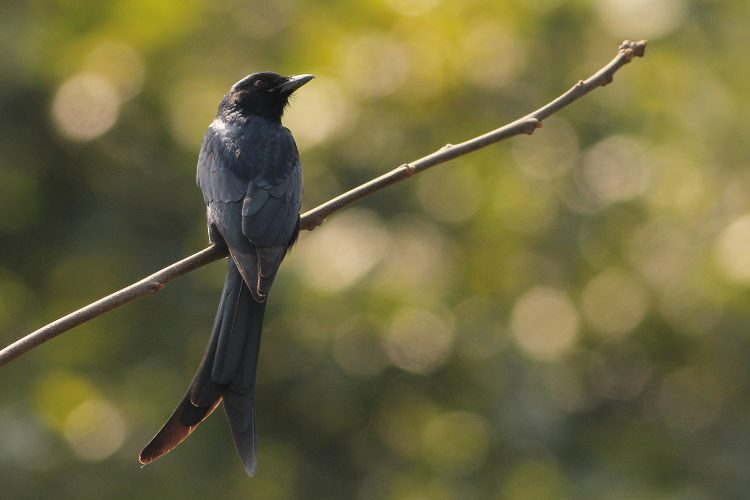All black, the black drongo (Dicrurus macrocercus) is a small Asian passerine bird. This blackbird belongs to the drongo family, Dicruridae. This bird is a common resident breeder in Iran, Pakistan, India, Sri Lanka, China, and Indonesia. The Black Drongo has a distinctively formed tail. It feeds on insects and measures 28 cm in length.
They fly with strong flaps of the wing and are capable of fast maneuvers that enable them to capture flying insects. They are found as summer visitors to northeastern Afghanistan and northern Pakistan but are residents from the Indus Valley until Bangladesh and into India and Sri Lanka.
This whole blackbird is common in open agricultural areas and light forests, perched conspicuously on a bare perch or along power lines. The Black Drongo has aggressive behavior towards much larger birds. Like crows, they never hesitate to dive-bomb any bird of prey that invades their territory.
Due to aggressive behavior, this bird earns the informal name of king crow. They are aggressive and fearless birds; they will attack much larger species that enter they’re nesting territory, including crows and birds of prey. A superstition in central India is that cattle would lose their horn if a newly fledged bird alighted on it.
The black drongo was previously grouped along with the African fork-tailed drongo (Dicrurus adsimilis). The Asian forms are now treated as separate species with more than a few distinct populations. The species was once considered a subspecies of the fork-tailed drongo (Dicrurus adsimilis).
It has a close relative that has diverged relatively recently. The two are now considered distinct species, with the fork-tailed drongo restricted to Africa and separated from the Asian range of the black drongo. Black drongos were introduced just before the Second World War from Taiwan to the island of Rota to help in the control of insects.
The adults usually have a small white spot at the base of the gape. The iris is dark brown; however, the sexes cannot be told apart in the field. Juveniles are brownish and may have some white barring or speckling towards the belly and vent, and can be mistaken for the white-bellied drongo. Play behavior has been observed with birds dropping a leaf in the air and catching it in mid-air, and these may possibly help young birds acquire aerobatic skills.
First-year Drongo birds have white tips on the feathers of the belly, while second-year birds have these white-tipped feathers restricted to the vent. It has short legs; they sit upright on thorny bushes, bare perches, or electrical wires. They may also perch on grazing animals. They are capable of producing a wide range of calls but a common two-note tee-hee call resembles that of the Shikra.
Black Drongos become active very early at dawn and roost later than many other birds. They associate with common mynas, cattle egrets, and other birds that share the same diet and habitat. Black Drongos are bred mainly in February and March in southern India and until August in other parts of the country.
Both male and female birds like to sing in the mornings during the breeding season. Courtship can include aerobatic chases, and they may lock their wings and beaks together, with the pair sometimes falling to the ground. Displays may be made on the ground. Pair bonds are retained for the whole breeding season.
The nest is a cup shape, which is made with a thin layer of sticks placed in the fork of a branch and is built in a week by both the male and female. The usual clutch is three or hardly ever four eggs laid in a cup nest placed in the fork of an outer branch of a tree. The egg’s colors are pale cream to red with spots and markings, and it is 26 mm long and 19 mm wide.
Both parents incubate eggs, which hatch after 14 to 15 days. Both sexes continue to feed and protect them for a month. Young birds beg for food for longer but are often ignored or chased away by the adults. Their inclination to drive away predators from near their nests is believed to encourage other birds, such as orioles, doves, pigeons, babblers, and especially bulbuls, to nest in the vicinity.
Also Read: The Golden-Breasted Starling










